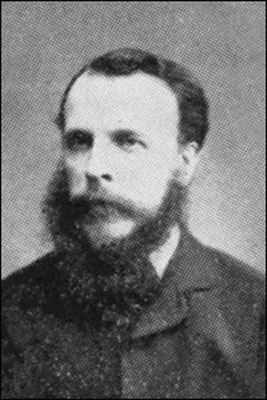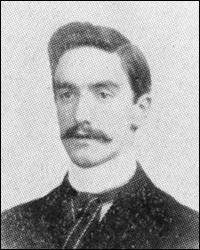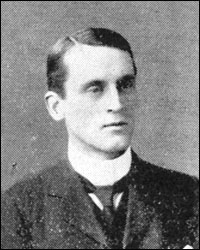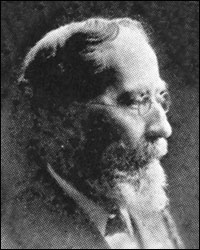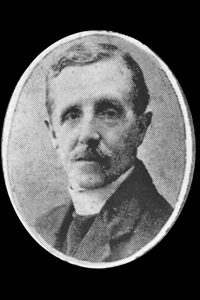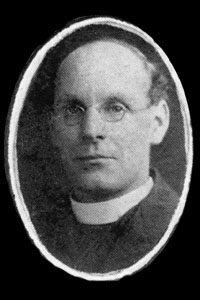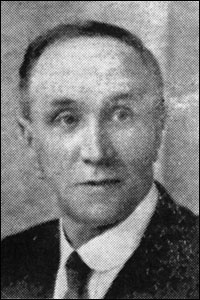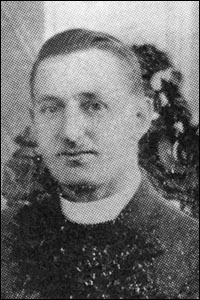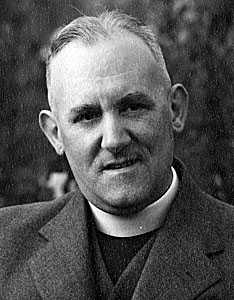|
||||||||||||||||||||||
|
|
||||||||||||||||||||||
|
After John Yeomans death in 1766, the pastorate was held by Mr Tift for two years, then by Mr Baker and a Mr Stanger, who died in 1793. By this time there were only four members of the church. Mr William Barnes was the next pastor from 1791 until his death in 1799. Upon his death it was recorded that Mr Barnes was a "Character greatly and deservedly repected; modest and disinterested; a uniform Christian and a laborious minister." From 1800-02, the church was at its lowest ebb, there were only six members, and all widows. In 1802, Mr James Ward from Kettering, a regular preacher in Burton Latimer, and five others were invited to form a new Church. So Maydwell's Church, Burton Latimer, began with James Ward as pastor. Mr Ward was pastor for two years, but the church book notes that he was a bad man and a "wolf in sheeps clothing", and he was dismissed from the church for his behaviour. This resulted in the dissolution of the church. Over the next few years, Burton was visited by pastors from the Barton Lodge, which led to the reformation of the church in 1805 with a new pastor, Mr James Presland. However, although Mr Presland continued as minister for a further 22 years, the church was dissolved again in 1808, and commenced anew with ten members. Mr Presland was described as "A good man, but not a very successful minister". At this time Rev T. Grimshaw was the rector at St Marys, and it was not uncommon for the rector to join with his non-conformist neighbours in their services and for the baptist minister and his flock to return the compliment. Rev Grimshaw was a popular and powerful preacher and possibly one or two of the baptist congregation may have left the church to attend St Marys. In 1813 a Sunday school began. This consisted of 10 scholars and took place in the sitting room of the cottage opposite the chapel, and then later in the vestry of the chapel. In 1828, 21 year old Francis Gardner took over the role of pastor. After two years in Burton Latimer, Rev Gardner was designated as a missionary under the Baptist Missionary Society and sailed to Jamaica. He was based at Fullers Field and preached to all the local people, including slaves. This was before the abolition of slavery, and these actions were frowned upon by the landowners and planters. When insurrection broke out in 1832, he narrowly escaped with his life. After being tarred and feathered, a fire was to be set around him, but he was fortunately rescued from his foes. However, Rev Gardner along with two other missionaries, Knibb and Burchell, had to face the March Assizes at Montego Bay, where all were charged with numerous crimes. But the evidence against the missionaries was so ridiculous that the Attourney-General could not proceed with the charges. Rev Gardner continued to serve in Jamaica, until at last in 1834, slavery was abolished. This was celebrated by 126 of the congregation being baptised. Unfortunately, Rev Gardners life was cut short by tropical fever and he died in 1838 aged 31. After the departure of Francis Gardner, the new minister was another young man, the Rev David Rees. Son of devout Welsh Baptist parents, Rees converted when nineteen years old. Rev Rees arrived fresh from Bradford College. His ministry was fruitful in development and progress, with the chapel enlarged in 1832 to seat 280 and also the rebuilding of the ministers house. The Sunday school was also revived, led by Samuel Dickinson, who served the church for a further 48 years. By 1837 there were 39 members, this was the year that Rev Rees resigned from Burton. He then moved to a parish in Nottingham where the chapel had to be doubled in size to accomodate the bigger congregations. Mr Rees then served in parishes in Sheffield, Isleham (Cambs) and finally Braintree in 1846. The church book here noted: "Mr Rees was considered a man of considerable intellectual power, but lacking popular talent." However, during his thirteen years at Braintree 117 new members were recieved into the church and Mr Rees had earned a reputation as doughty warrior for the rights of nonconformists. At the prompting of the Baptist Missionary Society Mr Rees emigrated to Australia, arriving at Melbourne in July 1859. Now a widower with six children, he undertook a number of brief pastorates in the local area before moving to South Yarra, then little more than a sparsely populated village. Mr Rees didn't have a guaranteed a salary, and never recieved more than £100 per annum. But he devoted himself to his work and within five years the small meeting house had been replaced by a fine tabernacle-style building. Whilst working in the area Mr Rees made a survey of the gold mining area for the Victorian Baptist Association (VBA), however they could not sustain any baptist presence. Stirred by the needs of these isolated settlers, Mr Rees enthused his own congregation to offer aid. In time Mr Rees and his helpers revitialised the VBA, which in time became the Baptist Union of Victoria Throughout this period Mr Rees maintained his strong nonconformist stance, insisting on a separation of church and state. these views were accepted by the Association and forwarded to Parliament, provoking dissension among Baptist churches. By 1868 poor health had compelled Mr Rees to resign his pastorate, however, he still managed to travel throughout Victoria encouraging new congregations. In 1871 he was instrumental in the formation of a state missionary society to plant churches and train ministers. After a long and rewarding church career in Australia, Mr Rees died there in 1885. After several weeks of preaching at the church Rev Joseph Ashford was appointed in early in 1838. In 1839, ninteen persons were baptised and for the first time, four deacons were appointed. The Sunday school was very popular, with fifty scholars. This resulted in a number of classes taught by different teachers. In 1843 Mr Ashford moved to Harpole, where he remained for eight years before retiring to Oakham, where he died in 1854. Rev Ashford was followed by one of Burtons longest serving churchmen. Rev William May took up post on February 12th 1843 and remained as minister for the next 38 years, this period saw the expansion of the baptist church within Burton Latimer. In 1844 a burial ground was laid out south-west of the lower schoolroom. This was because permission to conduct services in the parish churchyard had been refused, which had led to the pastor addressing mourners from a chair outside the wall. In July 1848 the lower schoolroom was opened. Built at a cost of £100, this gave the church a dedicated space for Sunday school and helped to increase the number of scholars in the following years. In 1871 the church was also licensed for marriages. In 1878 a small plot of land was purchased and the alteration of the chapel and construction of a new vestry, at the cost of £770 completed.
Rev May was a most devouted minister and also had a deep knowledge of medicine. He oversaw the first internment in the chapel burial ground and also the first marriages in the chapel. In 1881 he ceased to be minister and his place was taken by Rev David Llewellyn. Mr Llewellyn was very successful and kept membership steady until he moved onto London to become minister at Upper Tooting in 1885. On October 6th 1885, Mr Thomas Collings became the settled pastor. Born in Gloucester and the son of a minister, Mr Collings was well known in the district as the editor of the "Wellingborough News" and later (1897) was the first editor of the "Kettering Leader". His style of preacing and personality began to attract people to the chapel and with the help of his wife quickly added to the young people attending church. In 1886 a new schoolroom, the Assembly Room was built to house the growing numbers at Sunday school. In 1889 the chapel was enlarged, with gas lamps replacing the oil lamps. Then in 1892, the old schoolroom was renovated for use by the infants. An upper floor was added to accommodate the senior scholars. The "Band Room" (in Alexandra Street) was also hired to cope with the ever growing numbers attending Sunday school. Mr Collings was a vibrant, dynamic man and when the Parish Council was formed, he was elected chairman. Mr Collings was involved in numerous projects to improve the town, including the formation of the Gas Company, which brought gas light and power to Burton Latimer. But possibly his most significant action was to introduce a new school. The only day school in the town was run by the Anglican church, but more than half the pupils were from Free Church homes. Nonconformists had requested they be represented on the board, but this had been refused. There was also an issue of Free Church members wishing to become teachers. To do so at the current school, they would have to forsake their religion and join the Anglican Church. As a result, a school board was formed with Mr Collings elected as chairman. However, the Board of Education refused to provide the school board with any additional accomodation, in spite of increased numbers. This led to Mr Collings taking the bold decision to build their own block of school buildings. Mr Collings raised an appeal across the country to generate funds for the project, and by 1898, a block of modern school buildings was built in the High Street, allowing equal opportunity for all in Burton Latimer. However,with great sorrow among the congregation, Mr Collings resigned the pastorate in 1896, but left both the church and Sunday school in a flourishing condition.
From 1886 Rev G.C. Leader became pastor, leaving for the parish of Kegworth and Diseworth, Leicestershire in 1899. During this period, the band practice room in Alexandra St was bought for £100 in 1897. This was used for mid-week and Sunday services, Sunday school classes and social events. Mr Collings took over for a short period, assisted by Rev R.E. Letheren as pastor. Mr Collings left in 1900, with Rev Letheren continuing until 1903 when he left to take up a position in Kingsthorpe. The Rev Isaac Watts took up the post between 1903 and 1906, with the balance of payments on the Assembly Room finally cleared during this time. Rev Watts had to leave due to ill health and retired to Bedford. In 1907 Rev T. S. Burros commenced his ministry. Having previosly been working in Camberwell, Mr Burros took to the role with much vigour, and endeared himself to all connected with the church. He was ably assisted by his wife who took a keen interest in the Sunday school and the ladies' sewing circle. During his time at Burton, Mr Burros was elected as president of the Northamptonshire Baptist Union. Mr Burros had ten happy and rewarding years at Burton, however, tragedy also befell the couple with the loss of their son, Phil, who was killed in action during World War One. In 1917 Mr Burros accepted the call to Shipston-on-Stour, but left behind fond memories of a wholehearted and enthusiastic ministry.
In Early 1918, Rev A. E. Bradford arrived in Burton from a ministry in Sheerness. Mr Bradford had been educated at Stepney and Edinburgh, and had held charge of churches in both Edinburgh and London before settling in Sheerness in 1913. He worked hard to build up the local church and was also "officiating clergyman" for the nearby barracks. The local newspaper reported on his departure, stating that: "The district will be the loser of a vigorous personality by his removal. He has found it necessary to take this step due to the illness of Mrs Bradford, whose nervous system has not recovered from the shock occasioned by the air raid last June. Eminent medical advice has been obtained, and is to the effect that it is inadvisable for Mrs Bradford to return to Sheerness and, under the circumstances her husband feels it incumbent upon him to seek an appointment in some part of the country in which his wife can recover her normal health. Mr Bradford is a strong, capable pastor with a gift for organisation. Of great religious fervour, and drawing on a strong dividing line between right and wrong, he inspired members of his congregation to take a greater and more practical interest in Christian work - Mr Bradford will undoubtedly be much missed." Mr Bradford was not only an eloquent preacher, but a great organiser and very popular with the younger church members. During his tenure, services were well attended, in spite of the war. Numbers at the Assembly Room were 120, three bible classes with 64, 21 and 19 attending, as well as those who attended the school held in the Mission Room, Alexandra St. A prayer meeting was also held once a month in the senior classroom with nearly seventy being present. Mr Bradford also instigated a ladies' choir, which he conducted and supervised a boys' club at the Alexandra St Mission. However, his wife began to suffer ill health once again and Mr Bradford was advised to leave Burton for her sake. So in 1919 he took up a ministry in Thornton Heath, Surrey. Rev F. W. Willshire was the next pastor. Arriving from Farringdon, he was a young man with a good knowledge of carpentry and cabinet-making. Prior to entering the ministry, he had made a number of useful suggestions for work that was to be undertaken in the chapel. A highlight of Mr Willshire's time was the Spring Time Bazaar in 1921. Held during three days in March, and with many members of the church involved, the event was a great success - raising £1,308. The church was also undergoing significant building work during this time; the eastern wall was removed and put on a level with the gallery, with choir stalls and an organ chamber constructed below what had been built. The baptistry was modernised and a new pipe organ presented by the treasurer, Mr Chas. Barlow in memory of his wife. The work on enlarging and renovating the chapel was finally completed, and officially opened on 25th August 1921. In 1922, Rev Willshire resigned his pastorate and was succeeded by Rev John Robins, arriving from Stevenage in 1923. Mr Robins was a very earnest preacher, and had some very definite and decided views on church management, which at the time caused some consternation amongst some church members. However, these differences of opinion were smoothed over. Whilst at Burton, Mr Robins suffered the loss of his wife, who caught a chill whilst on holiday in Wales and rapidly declined. Two senior church members also passed away; Charles Barlow in January 1923 and Charles Stokes in August 1923. The Rev Robins terminated his ministry in 1931, and Rev C. P. Thomas of Oxford was invited to become pastor in 1932.
Mr Thomas was described as "a man of outstanding personality and infectious good nature". With the assistance of his wife, Mr Thomas contributed greatly to the welfare of the men of Burton, these were hard times and he played an active part in the collecting and distributing funds so the unemployed men might have assistance. Mr Thomas also held a Sunday afternoon mens meeting, which was well attended, but he was at his best at the "Men's Fireside" when he visited individuals to offer guidance and encouragement. Mrs Thomas also contributed greatly to the Women's Union and the ladie's bible class. It was during this period that Mr H. Chamberlain, a stalwart of the church, was elected as president of the Northamptonshire Baptist Union, an office he held with distinction. After five years sterling work, Mr Thomas left to take up a position in Great Missenden. In 1938 Rev. A.A. McNaughton entered the ministry, having previously been working in Speen, and was minister during the bicentenary in 1944. This was a difficult time for the church and the town, and a number of activities had to lapse. Forty men from the bible class were called into the forces or working in the munitions plant, and a number of the young women had to find employment in the essential industries. Because of the war, fir the first time in the history of the church, Deconesses were appointed and undertook their work faithfully and well. Mr McNaughton served until 1946, followed by the Rev V.F. Smither. DEATH OF THE REV. V.F. SMITHER
|
||||||||||||||||||||||

